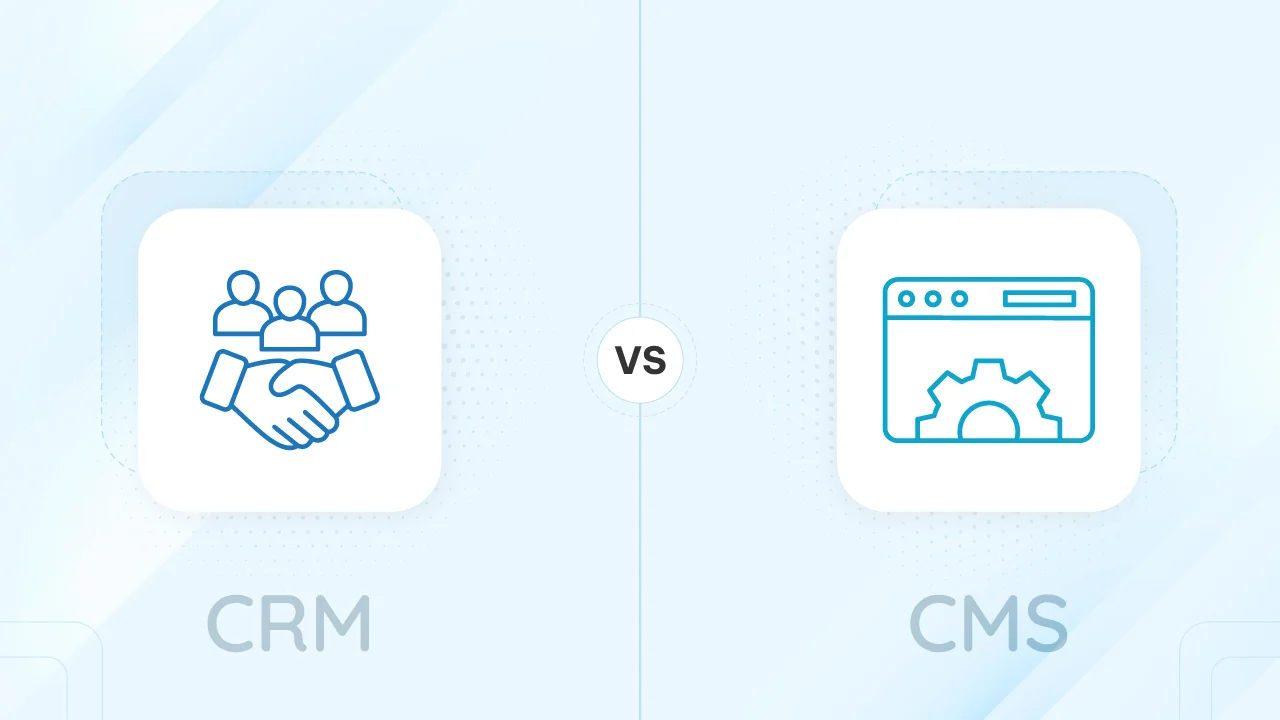Today, businesses constantly look for ways to streamline operations, enhance customer experiences, and manage content effectively. Two essential tools that can help achieve these goals are Customer Relationship Management (CRM) systems and Content Management Systems (CMS). While both systems offer significant benefits, they serve different purposes and are designed to address distinct aspects of business operations.
Learning the differences between CRM and CMS is essential for businesses to optimize their operations. Each system plays a unique role: CRMs are necessary for nurturing customer relationships and driving sales, while CMSs are vital for managing and publishing content online. Choosing the right system– CRM vs. CMS– can significantly impact a business’s efficiency and overall success.
By understanding their features, benefits, and use cases, you will be better equipped to decide which system, or combination of systems, best meets your business’s specific needs and goals. Whether you aim to enhance customer interactions or streamline your content management, this guide will help you make an informed decision that supports your business objectives.
Understanding CRM (Customer Relationship Management)

Customer Relationship Management (CRM) systems are comprehensive tools designed to manage and improve a company’s interactions with current and potential customers. The primary goal of a CRM system is to create a centralized platform that gathers and organizes all customer-related information, facilitating better communication, stronger relationships, and enhanced customer satisfaction. By consolidating data from various channels, a CRM system helps businesses gain valuable insights into customer behavior and preferences, enabling more personalized and effective engagement.
A CRM system serves several critical functions within a business:
- Contact Management: At the core of a CRM is the contact database, where all customer information is stored. This includes names, addresses, phone numbers, emails, and any interactions the customer has had with the company. By centralizing this information, businesses can quickly access and update customer details, ensuring that everyone in the organization has access to the most current data.
- Sales Management: CRM systems offer tools to manage the entire sales process, from lead generation to deal closure. Sales teams can track leads, set follow-up reminders, and monitor the progress of sales opportunities. Features like sales forecasting, pipeline management, and performance analytics help sales managers make informed decisions and improve sales strategies.
- Customer Service and Support: CRMs enable customer service teams to provide efficient and effective support. By logging customer inquiries, complaints, and service requests, the system ensures that issues are tracked and resolved promptly. Support agents can view a customer’s history, providing context for each interaction and improving the overall customer experience.
- Reporting and Analytics: One of the significant advantages of a CRM system is its ability to generate detailed reports and analytics. Businesses can analyze customer data to identify trends, measure performance, and make data-driven decisions. These insights can help refine marketing strategies, improve sales tactics, and enhance customer service.
Examples of Popular CRM Systems
Several CRM systems are widely recognized for their robust features and ease of use:
- Salesforce: Salesforce is one of the most comprehensive and popular CRM platforms available. It offers a wide range of tools for sales, customer service, marketing, and analytics. Salesforce’s cloud-based solution is highly customizable, allowing businesses to tailor it to their specific needs.
- HubSpot: HubSpot CRM is known for its user-friendly interface and powerful marketing automation features. It provides tools for contact management, sales tracking, and customer service, as well as a suite of marketing tools to help businesses attract and engage customers.
- Zoho: Zoho CRM offers a versatile and affordable solution for businesses of all sizes. It includes features for sales automation, marketing campaigns, customer support, and analytics. Zoho’s integration with other Zoho products and third-party applications makes it a flexible choice for many businesses.
Benefits of Using a CRM
Using a CRM system offers several key benefits to businesses:
- Improved Customer Relationships: CRMs centralize customer data, allowing businesses to understand their customers better. This leads to more personalized interactions, improved customer satisfaction, and stronger long-term relationships.
- Enhanced Sales Performance: CRM systems provide tools for managing leads, tracking sales opportunities, and analyzing sales data. This helps sales teams prioritize leads, forecast sales more accurately, and ultimately increase sales effectiveness.
- Better Customer Retention: By maintaining a comprehensive view of customer interactions and preferences, CRMs enable businesses to anticipate customer needs and deliver proactive service. This leads to higher customer retention rates and reduced churn.
- Streamlined Communication and Collaboration: CRMs facilitate seamless communication and collaboration across teams. Employees can easily share information, track customer interactions, and coordinate efforts to deliver a cohesive customer experience.
Understanding CMS (Content Management System)
A Content Management System (CMS) is a software application that allows users to create, manage, and publish digital content on the web. CMS platforms provide a user-friendly interface that simplifies the process of content creation, editing, and maintenance without requiring extensive technical expertise. These systems are essential for businesses and individuals looking to build and manage dynamic websites efficiently.
CMS platforms serve several primary functions:
- Content Creation and Editing: Users can create, edit, and format digital content such as text, images, videos, and documents. The built-in text editors and WYSIWYG (What You See Is What You Get) interfaces make it easy to publish content without writing code.
- Media Management: CMS systems include features for uploading, organizing, and managing media files. Users can easily insert images, videos, and other multimedia content into their web pages or posts.
- Design and Layout Customization: Offers templates and themes that allow users to customize the design and layout of their websites. Users can choose from pre-designed templates or create their own layouts using drag-and-drop editors.
- User Management: Provides tools for managing user roles and permissions. Administrators can define different levels of access for users, allowing them to control who can create, edit, publish, and manage content on the website.
Examples of Popular CMS Platforms
Several CMS platforms are widely used for building and managing websites:
- WordPress: WordPress is the most popular CMS globally, known for its flexibility, scalability, and extensive plugin ecosystem. It powers a significant portion of the internet, from personal blogs to complex corporate websites.
- Drupal: Drupal is a robust CMS favored by developers for its flexibility and scalability. It is ideal for building highly customized websites and web applications with complex functionalities.
- Joomla: Joomla is a versatile CMS that offers a balance between ease of use and advanced features. It is suitable for building websites, online stores, and social networking platforms.
Benefits of Using a CMS
Using a CMS provides several advantages for businesses and website owners:
- Simplified Content Management: Easily manage and update website content without relying on developers or IT support.
- Enhanced Website Design and Functionality: Quickly customize website appearance and add new features using templates and plugins.
- Improved SEO Capabilities: Optimize content for search engines to attract more organic traffic and improve search engine rankings.
- Efficient Collaboration and Publishing Workflows: Streamline content creation processes with workflow tools that support team collaboration and ensure timely publication.
Discover our proficiency in creating polished CMS solutions tailored to your needs.
CRM vs. CMS: Detailed Comparison
| Aspect | CRM (Customer Relationship Management) | CMS (Content Management System) |
|---|---|---|
| Focus and Primary Use Cases |
|
|
| Target Users Within a Business |
|
|
| Common Overlaps and Integrations |
|
|
Determining Your Business Needs
When deciding between a CRM (Customer Relationship Management) system and a CMS (Content Management System), it’s important to assess your business’s specific goals and requirements. This section will guide you through evaluating your needs and determining which system aligns best with your objectives.
Assessing Your Business Goals and Priorities
Before choosing a system, consider the following questions to clarify your business goals:
- Are you primarily focused on managing customer relationships and improving customer interactions?
- Is content creation, management, and website functionality enhancement a primary concern for your business?
Understanding your primary focus will help you prioritize which system—CRM or CMS—will better serve your immediate and long-term objectives.
Many companies get confused regarding their exact needs. They can simply be looking for a customer support/service solution but instead end up investing in a CRM/CMS that comes at an unnecessary cost. If you’re looking for an online, customer-facing solution only for customer support/service, a knowledge base platform is usually sufficient.
Identifying Key Stakeholders
Identify the key stakeholders who will be using the system:
- Sales Team: Will use CRM for managing leads, tracking sales opportunities, and enhancing customer relationships.
- Marketing Team: May require access to both CRM (for customer insights and targeted campaigns) and CMS (for content creation and publishing).
- Customer Support: Relies on CRM for managing customer inquiries, complaints, and support requests.
- Content Creators: Require CMS for creating, editing, and publishing content on the website.
Understanding who will use the system and their specific needs ensures that the chosen system meets all relevant requirements across different departments.
Evaluating Your Current Tools and Systems
Assess your current tools and systems to determine their effectiveness and identify any gaps:
- CRM Systems: Evaluate existing CRM systems (if any) in terms of usability, features, integration capabilities, and overall effectiveness in managing customer relationships.
- CMS Platforms: Assess current CMS platforms (if any) for ease of use, design flexibility, content management capabilities, SEO performance, and collaboration tools.
- Integration Needs: Identify if there’s a need for better integration between existing systems (e.g., CRM with CMS) to streamline operations and improve data flow.
Understanding the strengths and limitations of your current tools will help you make an informed decision about whether to adopt a new system or enhance existing ones to better meet your business needs.
Scenarios and Recommendations
Choosing the right system—CRM (Customer Relationship Management) or CMS (Content Management System)—depends on your business’s primary focus and operational needs. Here are scenarios and recommendations to help you decide which system or combination of systems is best suited for your business:
Scenario 1: Primarily Sales and Customer Service Focus
Recommended System: CRM
Explanation: For businesses primarily focused on managing sales processes, nurturing customer relationships, and providing efficient customer service, a CRM system is essential.
Here’s how a CRM can benefit this type of business:
- Lead Management: Capture, track, and manage leads effectively, ensuring no opportunity is missed.
- Sales Pipeline Management: Monitor sales opportunities from initial contact to closure, improving sales forecasting and performance.
- Customer Service: Centralize customer interactions, inquiries, and support requests to deliver prompt and personalized customer service.
- Marketing Automation: Automate marketing campaigns based on customer data and interactions to nurture leads and improve conversion rates.
📌 Example: A software company uses Salesforce CRM to manage its sales pipeline, track customer interactions, and provide timely customer support. Sales representatives use the CRM to prioritize leads, schedule follow-ups, and close deals efficiently, while the customer support team resolves inquiries promptly, leveraging CRM data for personalized assistance.
Scenario 2: Primarily Content Creation and Website Management Focus
Recommended System: CMS
Explanation: Businesses focused on creating and managing digital content, enhancing website design, and optimizing online presence benefit most from a CMS.
Here’s how a CMS can support this type of business:
- Content Creation: Easily create, edit, and publish content such as articles, blogs, videos, and images without technical expertise.
- Website Design: Customize website appearance and functionality using themes, templates, and plugins.
- SEO Optimization: Optimize content and meta tags for search engines to improve organic search rankings and attract more visitors.
- Collaboration: Enable multiple users to collaborate on content creation and publishing workflows, ensuring content is updated and relevant.
📌 Example: An e-commerce business uses WordPress CMS to manage its online store. The marketing team regularly updates product pages, publishes blog posts, and optimizes content for SEO. The CMS’s user-friendly interface allows them to maintain a visually appealing website that attracts and engages customers effectively.
Scenario 3: Need for Both Customer Management and Content Management
Recommended Approach: Using Both CRM and CMS
Explanation: Businesses that require robust capabilities in both customer relationship management and content management benefit from integrating CRM and CMS systems.
Here’s how integrating both systems can enhance business operations:
- Personalized Content Delivery: Integrate CRM data with CMS to deliver personalized content and offers based on customer preferences and behavior.
- Unified Customer View: Provide a holistic view of customer interactions across sales, marketing, and support channels, enhancing customer service and satisfaction.
- Efficient Workflows: Streamline processes by automating data synchronization between CRM and CMS, ensuring consistency and accuracy in customer data and content delivery.
📌 Example: A financial services firm integrates HubSpot CRM with Drupal CMS to manage client relationships and enhance its digital presence. The CRM captures client interactions, while the CMS facilitates content creation and updates. By integrating both systems, the firm delivers personalized financial advice through its website based on client profiles and preferences, improving client engagement and satisfaction.
Choosing the Right System(s) for Your Business

Selecting the appropriate system(s)—whether CRM (Customer Relationship Management), CMS (Content Management System), or both—requires careful consideration of various factors. This section outlines key considerations and steps to successfully implement your chosen system(s).
Key Considerations When Choosing a CRM or CMS
- Budget: Evaluate the costs associated with acquiring, implementing, and maintaining the CRM or CMS. Consider initial setup fees, licensing costs, ongoing support, and potential customization expenses.
- Scalability: Assess whether the system can scale with your business as it grows. Consider factors such as increasing user base, data volume, and feature requirements over time.
- Ease of Use: Choose a system that aligns with your team’s technical skills and capabilities. A user-friendly interface and intuitive tools can enhance adoption and productivity among users.
- Integration Capabilities: Ensure the CRM or CMS can integrate seamlessly with other systems and tools your business uses, such as marketing automation platforms, ERP systems, or e-commerce platforms. Integration capabilities are crucial for data consistency and workflow efficiency.
Steps to Implementing Your Chosen System(s)
- Planning and Strategy: Define clear objectives and goals for implementing the CRM or CMS. Identify key stakeholders, establish implementation timelines, and outline the desired outcomes.
- Selection and Procurement: Research and evaluate different CRM or CMS options based on your business requirements and budget. Consider conducting demos, seeking recommendations, and consulting with vendors or experts to make an informed decision.
- Implementation and Training: Plan the implementation process meticulously, considering data migration, customization needs, and system configuration. Provide comprehensive training to users to ensure they understand how to effectively use the new system(s).
- Ongoing Evaluation and Optimization: Continuously monitor and evaluate the performance of the CRM or CMS post-implementation. Gather feedback from users, assess system usage, and identify areas for improvement or optimization. In addition, regularly update the system(s) to leverage new features, address issues, and align with evolving business needs and industry trends.
Conclusion
Understanding the differences between CRMs (Customer Relationship Management) and CMSs (Content Management Systems) is essential for business growth and aiming to optimize their operations and achieve their goals effectively. Throughout this guide, we’ve explored how each system serves distinct purposes and plays critical roles in enhancing business performance.
If you’re unsure about which system best suits your business needs, don’t hesitate to seek professional advice or request a demo from CRM and CMS providers. Engaging with experts can provide technical knowledge and insights into specific features, integration possibilities, and customization options tailored to your industry and operational requirements.
Choosing the right CRM or CMS—or integrating both—can significantly impact your business’s ability to manage customer relationships effectively, optimize content creation and delivery, and ultimately achieve sustainable growth. Take the time to explore your options thoroughly and make an informed decision that aligns with your business objectives.
Explore our tailored CMS solutions to enhance website functionality, optimize SEO, and boost team collaboration.





